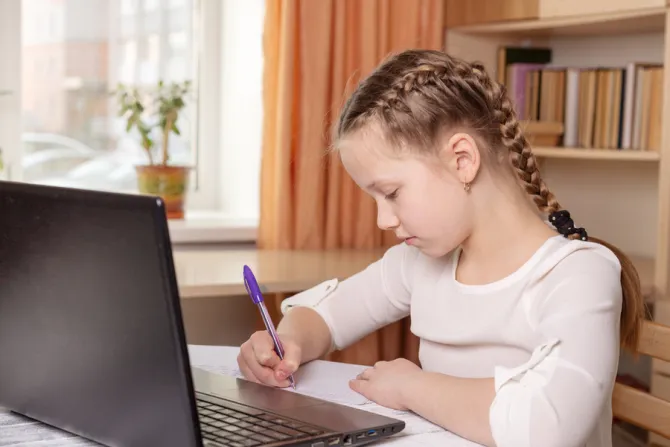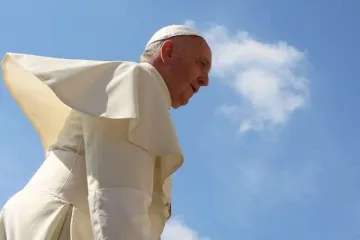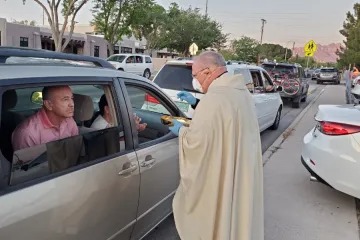Denver, Colorado, Apr 17, 2020 / 16:12 pm
It has been one month since most schools across the US closed their doors due to the coronavirus pandemic.
The solution to shuttered schools may seem simple, on the surface: move curriculum and teachers online. Teach classes on Zoom videos, assign and receive homework through Google Classroom, and send communications and grades via email or an online school portal.
But what happens when students, sent home to learn from their bedrooms or kitchen tables, do not have access to the internet at their house? Or when the whole family is studying or working from home, and the one computer in the household is needed by several people at once?
These are the questions Catholic schools have grappled with after the coronavirus forced the shutdown of schools across the nation, many of them for the rest of the school year.
The Archdiocese of Denver made the decision to close its schools on the night of Thursday, March 12. The following Friday had already been a planned day off for students and a working day for teachers, which was to the schools' advantage as they figured out how to shift completely to distance learning.
"All Thursday night we figured out, okay, what would have to be true to make distance learning successful in the next two weeks?" Abriana Chilelli, director of curriculum and instruction in the Denver archdiocese, told CNA.
"Certainly, technology rose to the top, but also that children had internet access, that schools were able to get devices out to students. So we put together a think sheet, if you will, about a school's capability of distance learning," she said.
Originally, Chilelli said, the Catholic school system was planning for a two-week closure, but with some thought that it could be extended in a more long-term way.
During those two weeks, Chilelli said, some teachers "chose the paper-based route," sending home packets with two weeks worth of materials with students.
During those initial two weeks, schools worked to get in touch with every family to evaluate their technology and internet needs for a longer-term closure.
"We realized...that we were short about 500 devices for students and 50 for teachers, plus 200 hotspots," said Carol Nesbitt, director of schools marketing and communications in the Archdiocese of Denver. Those were the numbers after the archdiocese's schools had already lent out whatever extra laptops and devices they had on hand.
"I heard of a student up in Glenwood Springs at St. Stephen's school. The principal said he was trying to use his mom's burner cell phone to get his assignments," Nesbitt told CNA.
"We've heard from other principals who have said that (student's families) have five people in one house, and mom and dad are both trying to work from home and they have one computer. So the kids can't get on their Zoom call because mom has a call with her boss and different things," she said.
The shortage motivated the office of schools to send out two emails, asking Denver Catholics to contribute to an emergency relief fund. So far, Nesbitt said, the fund has received $220,000 in donations, "which I think is incredible."
It's enough to start buying more computers and distributing them to families on a lending basis, Nesbitt said.
"The first 50 came yesterday...and we delivered to three schools right away, and the rest are coming in over the next few days. And we'll turn those around as quickly as possible," she said. "(It's) all hands on deck to try to deliver those, of course, using social distancing measures," she said. Families have also been able to pick up supplies from schools.
Chilelli said she thinks when it came to setting up long-term distance learning, Catholic schools were at an advantage because of their smaller sizes.
"I'm watching these large districts that, still a month later, don't have contact with such huge percentages of their students. So I just think it's a huge advantage of Catholic schools that we're smaller, we can be more nimble and we have this one-on-one relationship with all of our families," she said.
(Story continues below)
Dr. Brooke C. Tesche is the chancellor of education for the Diocese of Allentown, which has already announced that its schools will be closed for the remainder of the school year.
Tesche said while they've had some students who are lacking computers or tablets on which to do their work, the Catholic school system has been working to accommodate these students any way they can. One way, she said, has been through lending out existing technology at the schools to families.
Two local internet providers are currently offering free services in order to help students continue their education, which has also helped in Allentown.
"So many families who would not have been able to connect, are able to connect," she said.
Still, Tesche added, there are students who do not have computers on which to complete their homework. For these students, teachers are putting together paper learning packets with two weeks of materials at a time. Parents and students can either pick up their packets in person, or see the packets mailed to students.
"So it's definitely a challenge right now, but (teachers are) responding and using I think as many options as possible to make sure that the kids continue to move forward," she said.
Tesche emphasized that schools are moving forward in their curriculum - rather than providing students with busy work or enrichment activities, teachers are working to prepare their students to be ready for the next grade level, whether schools will resume in-person in the fall or not.
The Diocese of Allentown is also unique in that it has the only Catholic high school for students in recovery from substance addiction, Kolbe Academy.
The school is in its first full year of operation, and so while it is "unfortunate" that the coronavirus closed the school's doors in its first year, Tesche said those students have been able to move their instruction, and their counseling and therapy, completely online.
"We just had a student this week celebrate 100 days clean and sober," she said. "I'm really proud of that. They are doing really good work."
Additionally, the school system has also partnered with Catholic Charities at this time in order to be able to address any mental health or social-emotional needs that families might have, Tesche said.
"We're just dovetailing really nicely to make sure they have support of Catholic Charities," she said.
In Ontario, the Huron-Superior Catholic District School Board said in a meeting this week that the district has been accommodating students without access to technology by providing them with weekly paper packets. Teachers have adjusted instruction so that each week is planned out in advance, and students can complete the weekly work at their own pace.
"...(the students) enjoy having the freedom to complete their work (on their own schedule)...they can do all their Monday and Tuesday work on Monday. I've heard nothing but good things about the work. Surprisingly, no complaints," Anthony DeLorenzi, an H-SCDSB student representative, said during a board meeting this week, according to local news source SOOTODAY.com.
Rose Burton Spohn, H-SCDSB director of education, told the board that about 70 students in the district were lacking either computers or access to the internet, and that the packets were being delivered to students on an ongoing basis. Teachers have also made themselves available via phone calls to students who lack internet access, she said.
Catherine Thompson is the Superintendent of Catholic Schools for Diocese of Las Vegas. Thompson told CNA that while the district has had some students who lacked access to computers at home, educators were able to fill those needs with what the schools had on hand.
Thompson said that the schools prepared for the impending closures as they watched the development of the pandemic, and particularly how it was affecting some harder-hit states on the East Coast.
Part of that preparation included a couple of surveys sent to parents, asking them about their technological needs as well as what they would like to see out of the distance learning experience.
"(What) we needed to know was what type of devices would be available - iPads, tablets, are they Windows people, are they Mac people. So they provided us with that," Thompson said.
"Then the next thing we wanted to know was their shared access amongst the entire family. Then we were looking at what is your internet access like? Was it excellent? Like would you rate it as reliable or average, it's mostly reliable or very, very low quality or very limited? We needed to know if they had a printer, we needed to know if they had a scanner. Then we also wanted to know were they comfortable with us using things like YouTube with the children," Thompson said.
She added that they also asked about access to non-technology materials, such as paper, pens, or markers. Another part of the preparation included training teachers as well as some parents on how to use platforms such as Zoom or Google Classroom.
Thompson said the teachers and schools also focused on how to make distance learning most effective without students having to spend every moment of their day in front of a screen.
"There are a lot of different pieces that you can do both online and offline," she said. Some teachers have instruction time and then offline time for students to work.
Other teachers are getting creative and assigning things like "exercise or a drawing a picture or recording something, or just make a tent and go inside and read, little things that they could do both inside and outside," she said.
Chilelli, too, added that the Denver Catholic school system has always emphasized that technology should not be used in education for its own sake.
"When we were figuring out what must be true about distance learning, we wanted to make sure that yes, it happened at home, but it was also philosophically aligned with what we believe about education and specifically Catholic education," she said.
"We would always say that we don't think that education should happen behind a computer screen, and that children should be engaged with texts, with great texts, they should be engaged in human interaction, and with primary documents. So we always promoted distance learning as being necessarily very simple - that it should not be just attempting to take on a technology just simply because it was out there," she said.
Chilelli said the shift to distance learning also forced teachers to evaluate what the most essential learning standards were for each subject matter, and to focus their time and lessons on those most essential things.
"Let's make sure that everything we're asking students do is really worthy of their time, which we would always say, but even more importantly now," she said.
Overall, Thompson said she's been very impressed with the work both teachers and parents have done to make this new system work.
"I want people to know that our teachers are absolutely amazing. They are the lifeblood of our schools and they have just ...the way and the manner in which they have risen to the occasion, the positive feedback that we've heard from our parents," she said.
"They appreciate all the work that we're doing on behalf of all of our students. Our schools - while our campuses are closed - our schools are very much open," she said.
"The amazing teachers and principals, they've just done an amazing job working on behalf of our students. So I can't say enough good things. I think that there will be so many more positives to come out of what's been such a difficult situation."






